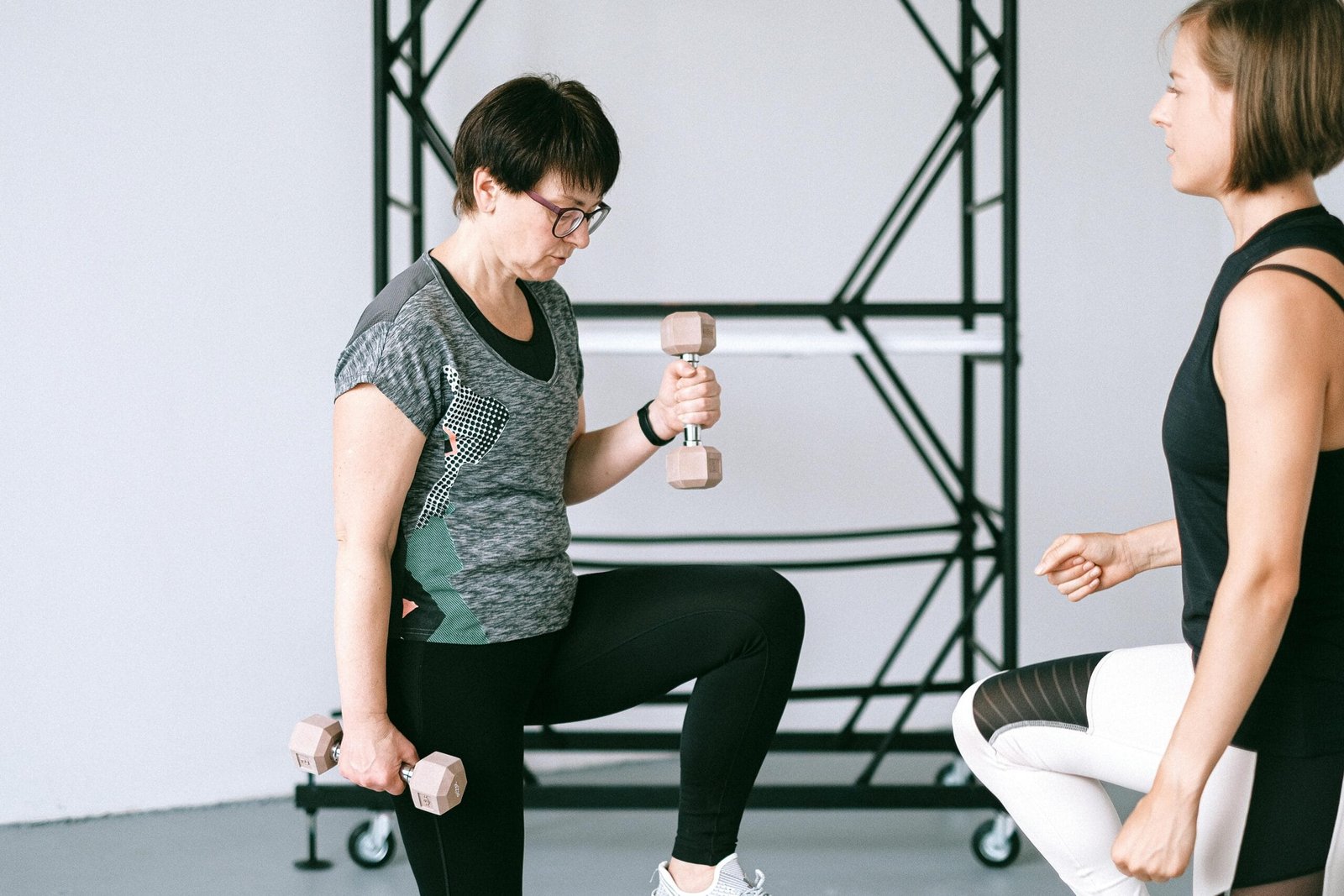Did you know women lose 3-5% of muscle mass each decade after 30? This fact shows how vital strength training is for women over 40. As you hit your 40s, exercise is key to keeping healthy and fit, even during menopause.
Strength training, or weight training, is a great way to stay fit after menopause. It helps build lean muscle, increases metabolism, and keeps bones strong. These benefits fight off the changes that come with age.
Adding strength training to your workout routine can boost your independence and lower disease risks. It also improves your overall health. No matter your fitness level, starting strength training can greatly benefit you.
Key Takeaways
- Women lose 3-5% of muscle mass per decade after age 30
- Strength training is key for health and fitness over 40
- Weight training builds muscle, boosts metabolism, and keeps bones strong
- Strength training fights age-related changes and improves life quality
- It’s never too late to start strength training in your fitness routine
The Importance of Strength Training for Women Over 40
Women over 40 need to focus on strength training. Resistance training helps keep them healthy and independent as they age.
Strength training fights muscle loss, or sarcopenia, that comes with age. By doing muscle building exercises, women can keep their strength and mobility.
Maintaining Muscle Mass and Bone Density
Strength training also helps keep bones strong. Women’s estrogen levels drop during menopause, raising osteoporosis risk. Weightlifting can stimulate bone growth and prevent osteoporosis.
“Strength training is the fountain of youth for women over 40. It keeps our muscles strong, our bones dense, and our metabolism firing on all cylinders.” – Dr. Miriam Nelson, author of “Strong Women Stay Young”
Boosting Metabolism and Weight Management
Strength training also boosts metabolism and helps with weight management. As we age, our metabolism slows, making it harder to stay slim. But, building lean muscle through resistance training can increase calorie burn, even at rest.
Adding strength training to your routine can help you stay healthy. It reduces the risk of obesity-related diseases like type 2 diabetes, heart disease, and some cancers.
Benefits of Strength Training for Midlife Women
As women hit their 40s and beyond, strength training is key for staying healthy. Regular resistance exercises bring many benefits. They can greatly improve midlife women’s quality of life.

Reducing Risk of Chronic Diseases
Strength training helps lower the risk of chronic diseases, like heart disease. This is a big worry for women over 40. By adding resistance exercises to their routine, they can boost their heart health, lower blood pressure, and manage their weight.
A study in the Journal of Women’s Health found a 17% lower heart disease risk for women who strength trained. This compared to those who didn’t.
| Chronic Disease | Risk Reduction with Strength Training |
|---|---|
| Heart Disease | 17% |
| Type 2 Diabetes | 30% |
| Osteoporosis | 40% |
Improving Mental Health and Mood
Strength training also boosts mental health and mood in women over 40. It releases endorphins, which are natural mood-boosters. These can help reduce stress, anxiety, and depression symptoms.
“Strength training not only helps me stay physically strong but also mentally resilient. It’s my go-to stress-buster and mood-lifter.” – Sarah, 45
Enhancing Overall Quality of Life
Strength training helps build strength, balance, and mobility. This makes daily activities easier and more confident. It improves overall quality of life, keeping women over 40 independent and active.
Adding strength training to your routine in your 40s and beyond can greatly impact your health. It reduces chronic disease risk, boosts mental health, and improves quality of life. Resistance exercises are a powerful tool for aging well and living fully.
Getting Started with Strength Training
If you’re a woman over 40 and new to strength training, it might feel overwhelming. But, with the right mindset and steps, you can start your journey to a stronger, healthier you. First, set clear goals, find a good workout space, and get the right equipment.
Before starting, think about your fitness goals. Do you want to boost your health, build muscle, or do daily tasks better? Knowing your goals will keep you motivated and focused.
Next, pick a place to work out, whether at home or the gym. If at home, make sure you have enough space and a place for your gear. Having dumbbells, resistance bands, and a stability ball can make your workouts more varied.
When lifting weights, start with light weights and focus on doing it right. As you get stronger, you can lift more and try harder exercises. Working with a certified trainer can help you learn the right techniques and create a workout plan just for you.
Being consistent is key in strength training. Try to work out at least twice a week, with rest days in between. Keep track of your progress and celebrate your wins.
“The journey of a thousand miles begins with a single step.” – Lao Tzu
By starting your strength training journey, you’re investing in your health for the long term. Embrace the challenge, stay committed, and watch your strength and confidence grow.
| Equipment | Purpose |
|---|---|
| Dumbbells | Versatile for various exercises targeting different muscle groups |
| Resistance Bands | Portable and effective for building strength and flexibility |
| Stability Ball | Enhances core stability and can be used for balance exercises |
Essential Strength Training Exercises for Women Over 40
As a woman over 40, adding strength training exercises to your routine is key. It helps keep muscle mass, bone density, and health in check. Compound exercises and functional movements work on many muscles at once, making your workouts more effective.

Squats and Lunges
Squats and lunges are vital for your lower body. They work your quadriceps, hamstrings, and glutes. These exercises boost leg strength, balance, and stability, helping you stay mobile and avoid falls.
Push-ups and Dips
Push-ups and dips focus on your upper body. They target your chest, shoulders, and triceps. These exercises keep your upper body strong and help with daily tasks like pushing and lifting.
“Strength training is not about being bulky or masculine. It’s about being strong, confident, and capable in your own body.” – Jen Sinkler, fitness expert
Rows and Pull-ups
Rows and pull-ups strengthen your back, shoulders, and biceps. They improve posture and reduce back pain. They also counteract the effects of sitting for long times.
Deadlifts and Hip Thrusts
Deadlifts and hip thrusts target your glutes, hamstrings, and lower back. These exercises are key for hip strength and stability. They help with walking, running, and climbing stairs.
Adding these essential exercises to your routine fights age-related muscle loss. It helps you stay independent and improves your quality of life as a woman over 40.
Proper Form and Technique for Safe and Effective Training
When you do strength training, proper form is key. It helps you get the best results and avoid injuries. Learning the basics and moving forward safely makes your workouts effective and lasting.
Mastering the Basics
First, learn the basics. Start with exercises like squats, lunges, push-ups, and rows. Make sure to keep your posture right, engage your core, and breathe well during each move.

- Keep your spine neutral and avoid rounding or arching your back
- Engage your core muscles to stabilize your body
- Maintain proper alignment of your joints
- Use a slow and controlled tempo, avoiding momentum
“Proper form is the foundation of any successful strength training program. It not only helps you get the most out of each exercise but also reduces your risk of injury.” – Sarah Johnson, Certified Personal Trainer
Progressing Safely
When you get better at the basics, you can try harder exercises. But, increase the challenge slowly to avoid hurting your muscles and joints.
| Progression Level | Recommended Approach |
|---|---|
| Beginner | Focus on mastering proper form with bodyweight exercises or light weights |
| Intermediate | Gradually increase weight or resistance, aiming for 2-3 sets of 8-12 repetitions |
| Advanced | Incorporate more complex exercises and variations, while maintaining proper form |
Always put injury prevention first when you’re getting better at strength training. Pay attention to your body and ask a fitness expert if you’re unsure about form or technique.
Creating a Balanced Strength Training Program
When you’re planning your strength training workout plan, aim for a balanced program. It should cover all major muscle groups and include rest days. A good routine includes exercises for your legs, back, chest, shoulders, arms, and core.
To keep making progress and avoid hitting a wall, use the progressive overload method. This means you should slowly increase the weight, sets, or reps. It challenges your muscles to get stronger.
- Try to do 2-3 strength training sessions a week, with a day off in between.
- Choose compound exercises that work many muscles at once, like squats, deadlifts, and push-ups.
- Begin with lighter weights and focus on getting your form right before adding more weight.
- Do 2-3 sets of 8-12 reps for each exercise, adjusting based on your fitness level.
“The key to a successful strength training program is consistency and patience. Trust the process and celebrate your progress along the way.”
Always listen to your body and give it enough rest and recovery time. This is key for muscle repair and growth, and to avoid injuries. By having a balanced strength training program and using progressive overload, you’ll reach your fitness goals and stay strong and healthy in your 40s and beyond.
Why Strength Training is Important for Women Over 40s
Women in their 40s face unique health challenges. One major issue is sarcopenia, or muscle loss. This can make moving harder, increase fall risks, and lower life quality. But, strength training can fight these problems and boost overall health.

Combating Age-Related Muscle Loss
Sarcopenia is a natural aging process. But, strength training can slow it down or even reverse it. By doing resistance exercises, you grow muscle and keep lean body mass. This helps keep a healthy body shape and boosts metabolism, making weight management easier with age.
Studies show women can gain muscle and strength in their 40s and beyond with strength training. A Journal of the American Medical Directors Association study found older adults gained 2.4 pounds of muscle in 12 weeks.
Maintaining Independence and Mobility
Functional fitness is a big plus of strength training for women over 40. It builds muscle and connective tissue strength. This makes daily tasks like carrying groceries and climbing stairs easier and more confident.
Strength training also lowers fall and injury risks by improving balance and bone density. The National Osteoporosis Foundation says women can lose up to 20% of bone mass after menopause. Strength training helps keep bones strong and healthy.
| Age Group | Recommended Strength Training Frequency |
|---|---|
| 40-50 years old | 2-3 times per week |
| 50-60 years old | 2-3 times per week |
| 60+ years old | 2-3 times per week, with a focus on functional exercises |
Adding strength training to your routine is key for staying independent and mobile with age. Just a few hours a week of resistance exercises can bring many benefits and improve your life quality in your 40s and beyond.
Nutrition and Recovery for Optimal Results
To get the most out of strength training, focus on good nutrition and rest. Eating the right foods and resting enough can really help you improve. It’s key for your health and progress.
Fueling Your Body for Strength Training
Protein is vital for muscle growth and repair during strength training. Eat a diet rich in lean proteins like chicken, fish, tofu, and legumes. Having protein-rich snacks or meals within 30 minutes after working out helps with muscle recovery and growth.

Don’t forget to add complex carbs and healthy fats to your diet too. Complex carbs from whole grains, fruits, and veggies give you energy for workouts. Healthy fats in avocados, nuts, and olive oil support hormone production and health.
The Importance of Rest and Recovery
Rest and recovery are as important as the workouts themselves. Sleep helps your body fix and strengthen muscles. Try to get 7-9 hours of sleep each night to support your strength training goals.
Also, include rest days in your workout plan. Rest days let your muscles recover and prevent injuries. On these days, do light activities like yoga, stretching, or easy cardio to aid in recovery.
Recovery is not a luxury, it’s a necessity.
By focusing on nutrition and recovery, you’ll see better results from your strength training. This will help you stay healthy and active as a woman over 40.
Overcoming Barriers and Staying Motivated
As a woman over 40, adding strength training to your busy life can be tough. Work, family, and other duties make it hard to find time and energy for workouts. But, with the right approach and mindset, you can beat these challenges and keep moving forward.
Finding Time for Strength Training
Finding time for strength training is a big hurdle. Here are some tips to help:
- Schedule your workouts like appointments and treat them as non-negotiable commitments to yourself.
- Break up your workouts into shorter sessions throughout the day if you can’t dedicate a full hour at once.
- Incorporate strength training into your daily activities, such as doing squats while folding laundry or using resistance bands during TV commercials.
“The key to success is to start before you are ready.” – Marie Forleo
Dealing with Setbacks and Plateaus
Setbacks and plateaus are common in fitness. The trick is to not let them stop you. Here’s how to handle them:
- Focus on the progress you’ve made so far and celebrate your accomplishments, no matter how small they may seem.
- Reevaluate your goals and adjust your workout plan if necessary to keep challenging yourself.
- Seek support from a workout buddy, personal trainer, or online community to help you stay accountable and motivated.
Consistency is key in strength training. Even a few minutes each day can make a big difference. Stay focused on your goals, celebrate your progress, and don’t be too hard on yourself when faced with setbacks. With persistence and a positive attitude, you can overcome any barrier and achieve the strong, healthy body you deserve.
Strength Training Myths Debunked
There are many myths about strength training that can stop women over 40 from enjoying its benefits. Let’s clear up some common misconceptions.
One big myth is that lifting weights will make women bulky. But, women usually don’t have enough testosterone to build big muscles. Instead, strength training helps build lean, toned muscles that boost metabolism and improve body shape.
Another myth is that cardio is the only way to lose weight. While cardio is good for the heart and burning calories, strength training is key for weight management. Building muscle increases your resting metabolic rate, helping you burn more calories even when you’re not moving.
Some think they’re too old to start strength training. But, it’s never too late to start and enjoy the benefits. These include:
- Improved bone density
- Increased muscle mass
- Better balance and coordination
- Enhanced mental health and mood
Age is no barrier when it comes to strength training. In fact, it becomes even more important as we get older to maintain our muscle mass and bone density.
Lastly, some believe strength training is only for the young and fit. But, it’s good for anyone, regardless of age or fitness level. With the right form and progression, anyone can safely and effectively do strength training.
| Myth | Reality |
|---|---|
| Lifting weights makes women bulky | Women typically don’t have the testosterone levels to build large, bulky muscles |
| Cardio is the only way to lose weight | Strength training helps build muscle, which increases resting metabolic rate and aids in weight management |
| You’re too old to start strength training | It’s never too late to begin strength training and experience its numerous benefits |
| Strength training is only for young, fit individuals | Strength training is beneficial for people of all ages and fitness levels |
Don’t let these myths stop you from enjoying the benefits of weight training. Strength training is a powerful tool for improving your health, fitness, and quality of life.
FAQ
Q: How can strength training support women during menopause?
A: Strength training can support women during menopause by helping to combat the loss of muscle mass and maintaining bone density, which can be a concern during this time. It’s like having a secret weapon against the pesky changes that come with aging!
Q: Can regular weight training help prevent fractures in older women?
A: Absolutely! Regular weight training can help prevent fractures by increasing bone density and improving balance. Think of it as your personal superhero cape, fighting off the villain of osteoporosis!
Q: How often should women in midlife weight train for optimal benefits?
A: Training two to three times a week is recommended for women in midlife. This frequency can enhance muscle strength and overall physical activity levels, making you feel like the superhero you are!
Q: Is strength training really good for heart health in women?
A: You bet! Strength training is good for heart health in women as it can lower the risk of heart disease. It’s like giving your cardiovascular system a workout in a fabulous gym outfit!
Q: What types of strength training exercises are best for women over 40?
A: Strength training exercises two to three times a week can include body weight exercises, resistance bands, and weights. It’s all about finding what makes your muscles sing and your heart happy!
Q: How does strength training protect against the risk of death in older women?
A: Strength training may protect against the risk of death by improving overall fitness, muscle strength, and reducing the risk of chronic diseases. It’s like adding years to your life while making those years fabulous!
Q: What is the importance of muscle strength for women over 40?
A: Muscle strength is crucial for women over 40 as it helps maintain independence, enhances mobility, and reduces the loss of muscle mass. It’s your ticket to staying youthful and spry, even if your birth certificate says otherwise!
Q: How can I integrate strength training into my life effectively?
A: Start by incorporating training two times a week into your routine, mixing it with aerobic exercise. Finding a physical therapist or a trainer who specializes in training for women over 40 can also make the journey more enjoyable and effective!
Q: Why do 1 in 5 women over 40 avoid strength training?
A: Many women may feel intimidated or unsure about strength training exercises. However, understanding that strength training can support their health and well-being can encourage them to embrace it. Remember, you’re not alone—1 in 5 women are in the same boat!
Conclusion
We’ve looked at how strength training helps women’s health, focusing on those over 40. It keeps muscle mass, boosts metabolism, and lowers disease risk. It also boosts mental health and quality of life, helping you stay independent and mobile as you age.
Starting strength training might seem hard, but it’s doable. Learn the basics, progress safely, and mix up your workouts. Eat right, rest well, and keep going even when it’s tough. Overcoming obstacles and staying motivated is key to making strength training a lifelong habit.
Strength training is vital for women’s health, even more so for those over 40. By understanding its benefits, you can improve your health and well-being. Begin your strength training journey today and see how it can change your life.








